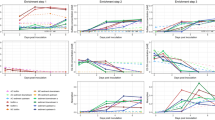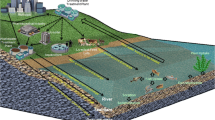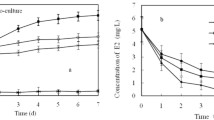Abstract
Natural estrogens (e.g., 17β-estradiol or 1,3,5[10]-estratriene-3,17β-diol) have been suggested as one of the major groups of substances that cause endocrine disruption in wildlife. There is little information in the open literature on the fate of natural estrogens in the environment, a fact thathinders the assessment of their ultimate impact on the ecosystem. Aerobic and anaerobic batch experiments involving a 17β-estradiol-degrading culture and a supernatant of activated sludge from a local sewage treatment plant (Burlington, Ontario) were undertaken to assess the persistenceof 17β-estradiol (E2) and its 5 metabolites. The batch experiments showed that E2 and the metabolites werenot persistent and could be rapidly degraded by sewage bacteria.Biodegradation of E2 by sewage bacteria appeared to initiate at the D ring of E2, leading to the formation of the major metabolite estrone (E1). No other major degradation products were noted. However, during the very earlystages of E2 degradation by sewage bacteria, a previouslyunreported metabolite, X1 (5-hydroxy-15-methyl-13-oxatetracyclo[8.7.0.0 <2,7> .0. <11,15>]-heptadeca-2(7),3,5-trien-14-one), was observed. X1 appeared to be a labilemetabolite with a lactone structure, but its significance in thebiodegradation of E2 remained to be elucidated. With theobservation of the new metabolite X1, a metabolic pathway of E2 by sewage bacteria was proposed. Conditions (e.g., aerobic and anaerobic environment) governing the persistence of E2 in sewage were also investigated. Results in this study suggest that the risk of extensive accumulation of natural estrogens normally found in sewage effluents in theenvironment is small, due to their ready biodegradation.
Similar content being viewed by others
References
Auger, J., Kunstmann, J. M., Czyglik, F. and Jouannet, P.: 1995, ‘Decline in semen quality among fertile men in Paris during the past 20 years’, New Engl. J. Med. 332(5), 281–285.
Bergeron, J. M., Crews, D. and McLachlan, J. A.: 1994, ‘PCBs as environmental estrogens: turtle sex determinations as a biomarker of environmental contamination’, Environ. Health Perspect. 102, 780–781.
Chang, L. T., Yu, N. W., Hsu, C. Y. and Liu, H.W.: 1996, ‘Gonadal transformation in male Rana catesbeiana tadpoles intraperitoneally implanted with estradiol capsules’, Gen. Comp. Endocriol. 102(3), 299–306.
Cohen, D. B. and Bryant, D. N.: 1978, ‘Chemical Sewage Sludge Disposal on Land’, Research Report No. 79, Canada-Ontario Agreement on Great Lakes Water Quality, Ontario Ministry of the Environment, Toronto.
Colborn, T., Vom Saal, F. S. and Soto, A. M.: 1993, ‘Developmental effects of endocrine-disrupting chemicals in wildlife and humans’, Environ. Health Perspect. 101, 378–383.
Coombe, R. G., Tsong, Y. Y., Hamilton, P. B. and Sih, C. J.: 1996, ‘Mechanisms of steroid oxidation by microorganisms: oxidative cleavage of estrone’, J. Biol. Chem. 241, 1587–1595.
Desbrow, C., Routledge, E. J., Brighty, G. C., Sumpter, J. P. and Waldock, M.: 1998, ‘Identification of estrogenic chemicals in STW effluent. I. Chemical fractionation and in vitro biological screening’, Environ. Sci. Technol. 32, 1549–1558.
Folmar, L. C., Denslow, N. D., Rao, V., Chow, M., Crain, D. A., Enblom, J., Marcino, J. and Guillette Jr., L. J.: 1996, ‘Vitellogenin induction and reduced serum testosterone concentrations in feral male carp (Cyprimus carpio) captured near a major metropolitan sewage treatment plant’, Environ. Health Prospect. 104, 1096–1101.
Foster, D. H. and Engelbrecht, R. S.: 1973, ‘Microbial Hazards in Disposing of Wastewater on Soil’, in W. E. Sopper and L. T. Kardos (eds), Recycling Treated Municipal Wastewater and Sludge through Forest and Cropland, The Pennsylvania State University, PA, U.S.A., pp. 247–270.
Harries, J. E., Sheahan, D. A., Jobling, S., Matthiessen, P., Neall, P., Routledge, E. J., Bycroft, R., Sumpter, J. P. and Tylor, T.: 1996, ‘A survey of estrogenic activity in United Kingdom inland waters’, Environ. Toxicol. Chem. 15, 1993–2002.
Harries, J. E., Sheahan, D. A., Jobling, S., Matthiessen, P., Neall, P., Sumpter, J. P., Tylor, T. and Zaman, N.: 1997, ‘Estrogenic activityin five United Kingdom rivers detected by measurement of vitellogenesis in caged male trout’, Environ. Toxicol. Chem. 16, 534–542.
Jobling, S., Sheaham, D. A., Osborne, J. A., Matthiessen, P. and Sumpter, J. P.: 1995, ‘Inhibition of testicular growth in rainbow trout (Oncorhynchus mykiss) exposed to environmental estrogens’, Environ. Toxicol. Chem. 15, 194–202.
Lee, H. B. and Peart, T. E.: 1998, ‘Determination of 17β-estradiol and its metabolites in sewage effluent by solid-phase extraction and gas chromatography/mass spectrometry’, J. Assoc. Off. Anal. Chem. International 81, 1209–1216.
Liu, D., Strachan, W. M. J., Thomson, K. and Kwasniewska, K.: 1981, ‘Determination of the biodegradability of organic compounds’, Environ. Sci. Technol. 15, 788–793.
Michael, R. L.: 1970, ‘Costs and manpower for municipal wastewater treatment plant operation and maintenance, 1965–1968’, J. Wat. Pollut. Control Fed. 42, 1883–1910.
Nichols, K. M., Miles-Richardson, S. R., Snyder, R. M. and Giesy, J. P.: 1999, ‘Effects of exposure to municipal wastewater in situ on the reproductive physiology of the fathead minnow (Pimephales promelas)’, Environ. Toxicol. Chem. 18, 2001–2012.
Routledge, E. J., Sheaham, D., Desbrow, C., Brighty, G. C., Waldock, M. and Sumpter, J. P.: 1998, ‘Identification of estrogenic chemicals in STW effluent. II. In vitro responses in trout and roach’, Environ. Sci. Technol. 32, 1559–1565.
Shore, L. S., Gurevitz, M. and Shemesh, M.: 1993, ‘Estrogen as an environmental pollutant’, Bull. Environ. Contam. Toxicol. 51, 361–366.
Spain, J. C. and Van Veld, P. A.: 1983, ‘Adaptation of natural microbial communities to degradation of xenobiotic compounds: Effects of concentration, exposure time, inoculum, and chemical structure’, Appl. Environ. Microbiol. 45, 428–435.
Spain, J. C., Prichard, P. H. and Bourquin. A. W.: 1980. ‘Effects of adaptation on biodegradation rates in sediment/water cores from estuarine and freshwater environments’, Appl. Environ. Microbiol. 40, 726–734.
Ternes, T. A., Kreckel, P. and Mueller, J.: 1999. ‘Behaviour and occurrence of estrogens in municipal sewage treatment plants — II. Aerobic batch experiments with activated sludge’, Sci. Total Environ. 225, 91–99.
Tyler, C. R., Jobling, S. and Sumpter, J. P.: 1998, ‘Endocrine disruption in wildlife: A critical review of the evidence’, Crit. Rev. Toxicol. 28, 319–361.
Author information
Authors and Affiliations
Corresponding author
Rights and permissions
About this article
Cite this article
Lee, H.B., Liu, D. Degradation of 17β-Estradiol and its Metabolites by Sewage Bacteria. Water, Air, & Soil Pollution 134, 351–366 (2002). https://doi.org/10.1023/A:1014117329403
Issue Date:
DOI: https://doi.org/10.1023/A:1014117329403




